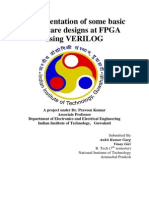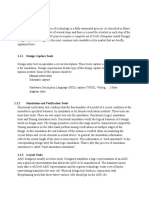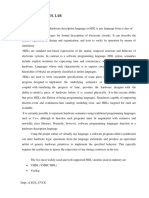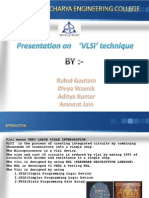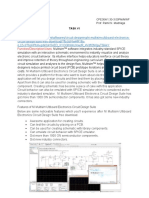Prelim Module1 - B
Prelim Module1 - B
Uploaded by
Celimen, John Renz C.Copyright:
Available Formats
Prelim Module1 - B
Prelim Module1 - B
Uploaded by
Celimen, John Renz C.Original Description:
Original Title
Copyright
Available Formats
Share this document
Did you find this document useful?
Is this content inappropriate?
Copyright:
Available Formats
Prelim Module1 - B
Prelim Module1 - B
Uploaded by
Celimen, John Renz C.Copyright:
Available Formats
PAMANTASAN NG CABUYAO
COLLEGE OF COMPUTING AND ENGINEERING
COURSE CODE: CPP 110
COURSE DESCRIPTION: INTRODUCTION TO HDL
COURSE INTENDED On the completion of the course, student is expected to be able to do the
LEARNING OUTCOMES: following:
1. The ability to code and simulate any digital function in HDL.
2. Understand library modeling, behavioral code and the differences
between them.
3. Understand the differences between simulator algorithms as well
as Logic verification using HDL software tool
4. Learn good coding techniques per current industrial practices
LEARNING MATERIAL FOR 1
WEEK NUMBER:
I. TITLE: Introduction to HDL
II. OBJECTIVES: By the end of this module you should be able to:
1. Gain familiarity on HDL field
2. Understand complexity of evolving electronics gearing to FPGA
3. Understand top-down and bottom-up design methodologies for
digital design.
III. INTRODUCTION:
The purpose of this module is to introduce what High Definition Language
is. The module discusses the digital logic design evolution and therefore
the basic ASIC design flow. It describes the need of ASIC SOC prototype.
The comparison of ASIC and FPGA implementation is described in these
sub-topics. This module is helpful to the HDL beginners to grasp about
the difference between problem-oriented language and HDL modeling
styles.
IV. CONTENTS:
Lesson Coverage:
- Introduction to High Definition Language
LECTURE NOTES COMPILATION Page 1 of 11
1st Semester A.Y. 2022-2023
PAMANTASAN NG CABUYAO
COLLEGE OF COMPUTING AND ENGINEERING
HIGH DEFINITION LANGUAGE (HDL)
Evolution of Computer Aided Digital Design
Digital circuit design has evolved rapidly over the last 25 years. The earliest digital circuits were designed with
vacuum tubes and transistors. Integrated circuits were then invented where logic gates were placed on one chip.
The first computer circuit (IC) chips were SS1 (Small Scale Integration) chips where the gate count was very
small. As technologies became sophisticated, designers were able to place circuits with many gates on a chip.
These chips were called MS1 (Medium Scale Integration) chips. With the arrival of LSI (Large Scale Integration),
designers could put thousands of gates on one chip.
At now, design processes started getting very complicated, and designers felt the requirement to automate these
processes. Computer Aided Design (CAD)' techniques began to evolve. Chip designers began to use circuit and
logic simulation techniques to verify the functionality of building blocks of the order of about 100 transistors.
The circuits were still tested on the breadboard, and also the layout was done on paper or by hand on a graphic
computer terminal. With the arrival of VLSI (Very Large Scale Integration) technology, designers could design
single chips with quite 100,000 transistors. due to the complexity of those circuits, it absolutely was unacceptable
to verify these circuits on a breadboard.
Computer-aided techniques became critical for verification and style of VLSI digital circuits.
Computer programs to try and do automatic placement and routing of circuit layouts also became popular. The
designers were now building gate-level digital circuits manually on graphic terminals. they'd build small building
blocks then derive higher-level blocks from them.
What is Hardware Schematics?
A hardware schematic is a diagram that shows hoe the combinational gates should be connected to achieve a
particular hardware functionality. In this case, it is the set of NAND gates connected towards the left. However,
if we know what values of inputs contribute to make the output have a value of 1, then we can essentially hide
the internal details of the connections and encapsulate it into a black box. This block provides us with certain
inputs and outputs that is similar to the hardware schematic made up of combinational gates.
Combinational NAND and NOR
https://www.chipverify.com/verilog/verilog-introduction
LECTURE NOTES COMPILATION Page 2 of 11
1st Semester A.Y. 2022-2023
PAMANTASAN NG CABUYAO
COLLEGE OF COMPUTING AND ENGINEERING
Hardware Description Language
Emergence of HDLs
For a protracted time, programming languages like FORTRAN, Pascal, and C were getting used to explain
computer programs that were sequential in nature. Similarly, within the digital design field, designers felt the
necessity for a regular language to explain digital circuits.
Thus, Hardware Description Languages (HDLs) came into existence. HDLs allowed the designers to model the
concurrency of processes found in hardware elements.
Hardware description languages like Verilog HDL and VHDL became popular. Verilog HDL originated in 1983
at Gateway Design Automation. Later, VHDL was developed under contract from DARPA. Both verilogB and
VHDL simulators to simulate large digital circuits quickly gained acceptance from designers.
Digital circuits can be described at a register transfer level (RTL) by use of an HDL. Thus, the looker had to
specify how the information flows between registers and the way the design processes the info. The details of
gates and their interconnections to implement the circuit were automatically extracted by logic synthesis tools
from the RTL description.
Typical Design Flow
A typical design flow for designing VLSI IC circuits is shown in Figure. Unshaded blocks show the extent of
design representation; shaded blocks show processes within the design flow.
In any design, specifications are written first. Specifications describe
abstractly the functionality, interface, and overall architecture of the
digital circuit to be designed.
At this time, the architects don't must consider how they will implement
this circuit. A behavioral description is then created to investigate the
planning in terms of functionality, performance, compliance to standards,
and other high-level issues. Behavioral descriptions may be written with
HDLs.
ASIC Design Flow (Courtesy: Verilog HDL by Samir Palnitkar)
LECTURE NOTES COMPILATION Page 3 of 11
1st Semester A.Y. 2022-2023
PAMANTASAN NG CABUYAO
COLLEGE OF COMPUTING AND ENGINEERING
Importance of HDL
1. HDLs have many advantages compared to traditional schematic-based design. Designs is described at a
really abstract level by use of HDLs. Designers can write their RTL description without choosing a
particular fabrication technology.
Logic synthesis tools can automatically convert the planning to any fabrication technology. If a
replacement technology emerges, designers don't have to redesign their circuit. They simply input the
RTL description to the logic synthesis tool and make a brand new gate-level netlist, using the new
fabrication technology.
The logic synthesis tool will optimize the circuit in area and timing for the new technology.
2. By describing designs in HDLs, functional verification of the look is done early within the design cycle.
Since designers work the RTL level, they will optimize and modify the RTL description until it meets the
required functionality.
Most design bugs are eliminated at this time. This cuts down design cycle time significantly because the
probability of hitting a functional bug at a later time within the gate-level netlist or physical layout is
minimized.
3. Designing with HDLs is analogous to programming. A textual description with comments is a better
thanks to develop and debug circuits. This also provides a concise representation of the planning,
compared to gatelevel schematics. Gate-level schematics are almost incomprehensible for very complex
designs.
Popularity of Verilog HDL
Verilog HDL has evolved as a standard hardware description language. Verilog HDL offers many useful features
for hardware design. Verilog HDL is a general-purpose hardware description language that is easy to learn and
easy to use. It is similar in syntax to the C programming language. Designers with C programming experience
will find it easy to learn Verilog HDL.
Verilog HDL allows different levels of abstraction to be mixed in the same model. Thus, a designer can define a
hardware model in terms of switches, gates, RTL, or behavioral code. Also, a designer needs to learn only one
language for stimulus and hierarchical design. Most popular logic synthesis tools support Verilog HDL. This
makes it the language of choice for designers.
All fabrication vendors provide Verilog HDL libraries for postlogic synthesis simulation. Thus, designing a chip
in Verilog HDL allows the widest choice of vendors.
The Programming Language Interface (PLI) is a powerful feature that allows the user to write custom C code to
interact with the internal data structures of Verilog. Designers can customize a Verilog HDL simulator to their
needs with the PLI.
Trends in HDLs
The speed and complexity of digital circuits has increased rapidly. Designers have responded by designing at
higher levels of abstraction. Designers must think only in terms of functionality. CAD tools be sure of the
implementation details.
LECTURE NOTES COMPILATION Page 4 of 11
1st Semester A.Y. 2022-2023
PAMANTASAN NG CABUYAO
COLLEGE OF COMPUTING AND ENGINEERING
With designer assistance, CAD tools became sophisticated enough to try and do a close-to-optimum
implementation. The most popular trend currently is to style in HDL at an RTL level, because logic synthesis
tools can create gate-level netlists from RTL level design.
Behavioral synthesis has recently emerged. As these tools improve, designers will be able to design directly in
terms of algorithms and also the behavior of the circuit, and then use CAD tools to try to to the interpretation and
optimization in each phase of the design. Behavioral modeling are going to be used more and more as behavioral
synthesis matures. Until then, RTL design will remain highly regarded.
Formal verification techniques are appearing on the horizon. Formal verification applies formal mathematical
techniques to verify the correctness of Verilog HDL descriptions and to ascertain equivalency between RTL and
gate level netlists. However, the requirement to explain a design in Verilog HDL won't go away.
For very high speed and timing-critical circuits like microprocessors, the gate level netlist provided by logic
synthesis tools isn't optimal. In such cases, designers often mix gate-level description directly into the RTL
description to achieve optimum results.
This practice is opposite to the high-level design paradigm, yet it's frequently used for high-speed designs because
designers need to squeeze the last little bit of timing out of circuits and CAD tools sometimes sway be insufficient
to realize the required results.
A trend that's emerging for system-level design could be a mixed bottom-up methodology where the designers
use either existing Verilog HDL modules, basic building blocks, or vendor-supplied core blocks to quickly point
out their system simulation.
Before we discuss the main points of the Verilog language, we must first understand basic hierarchical modeling
concepts in digital design. The designer must use a "good" design methodology to try and do efficient Verilog
HDL based design.
In this we discuss typical design methodologies and illustrate how these concepts are translated to Verilog. A
digital simulation is formed from various components. We discuss the components and their interconnections.
Design Methodologies
There are two basic sorts of digital design methodologies: a top-down design methodology and a bottom-up
design methodology.
In a top-down design methodology, we define the top-level block and identify the sub-blocks necessary to create
the top-level block. We further subdivide the sub-blocks until we come to leaf cells, which are the cells that can't
further be divided.
LECTURE NOTES COMPILATION Page 5 of 11
1st Semester A.Y. 2022-2023
PAMANTASAN NG CABUYAO
COLLEGE OF COMPUTING AND ENGINEERING
Figure 2 Top-down Design Methodology
In a bottom-up design methodology, we first identify the
building blocks that are available to us. We build bigger cells,
using these building blocks.
These cells are then used for higher-level blocks until we build
the top-level block within the design.
https://irreni.blogspot.com/2015/08/you-need-to-start-making-
political.html
Figure 2 shows the top-down design process.
Figure 2-1 Bottom-up Design Methodology
Typically, a combination of top-down and bottom-up flows is used.
Design architects define the specifications of the top-level block. Logic
designers decide how the design should be structured by breaking up the
functionality into blocks and sub-blocks.
At the same time, circuit designers are designing optimized circuits for
leaf-level cells. They build higher-level cells by using these leaf cells.
The flow meets at an intermediate point where the switch-level circuit
designers have created a library of leaf cells by using switches, and the
logic level designers have designed from top-down until all modules are
defined in terms of leaf cells
https://irreni.blogspot.com/2015/08/you-need-to-start-making-
political.html
Levels of Abstraction
Verilog language has the aptitude of designing a module in several coding styles. betting on the requirements of
a design, internals of every module are often defined at four level of abstractions. regardless of the inner
abstraction level, the module would behave exactly within the similar thanks to the external environment.
LECTURE NOTES COMPILATION Page 6 of 11
1st Semester A.Y. 2022-2023
PAMANTASAN NG CABUYAO
COLLEGE OF COMPUTING AND ENGINEERING
Following are the four different levels of abstraction which may be described by four different coding sorts of
Verilog language:
• Behavioral or Algorithmic level
• Dataflow level
• Gate level or Structural level
• Switch level
The order of abstraction mentioned above are from highest to lowest level of abstraction.
Verilog is both a behavioral and a structural language. Internals of every module will be defined at four levels of
abstraction, betting on the wants of the planning.
The module behaves identically with the external environment regardless of the amount of abstraction at which
the module is described.
The internals of the module are hidden from the environment. Thus, the amount of abstraction to explain a module
may be changed with none change within the environment. The levels are defined below.
Behavioral or algorithmic level
This is the very best level of abstraction provided by Verilog HDL. A module may be implemented in terms of
the specified design algorithm without worrying for the hardware implementation details. Designing at this level
is extremely almost like C programming.
Dataflow level
At this level the module is intended by specifying the information flow. The designer is attentive to how data
flows between hardware registers and the way the information is processed within the design.
Gate level
The module is implemented in terms of logic gates and interconnections between these gates. Design at this level
is analogous to describing a design in terms of a gate-level logical diagram.
Switch level
This is the bottom level of abstraction provided by Verilog. A module may be implemented in terms of switches,
storage nodes, and also the interconnections between them. Design at this level requires knowledge of switch-
level implementation details.
LECTURE NOTES COMPILATION Page 7 of 11
1st Semester A.Y. 2022-2023
PAMANTASAN NG CABUYAO
COLLEGE OF COMPUTING AND ENGINEERING
Verilog allows the designer to combine and match all four levels of abstractions in an exceedingly design. within
the digital design community, the term register transfer level (RTL) is usually used for a Verilog description that
uses a mix of behavioral and dataflow constructs and is appropriate to logic synthesis tools.
If a design contains four modules, Verilog allows each of the modules to be written at a special level of abstraction.
because the design matures, most modules are replaced with gate-level implementations.
Normally, the upper the amount of abstraction, the more flexible and technology independent the planning. joined
goes lower toward switch-level design, the planning becomes technology dependent and inflexible. A little
modification can cause a major number of changes within the design.
Modules
We now relate these hierarchical modeling concepts to Verilog. Verilog provides the concept of a module. A
module is that the basic building block in Verilog.
A module may be part or a set of lower-level design blocks. Typically, elements are grouped into modules to
supply common functionality that's used at many places within the design.
A module provides the required functionality to the higher-level block through its port interface (inputs and
outputs), but hides the interior implementation. this enables the looker to switch module internals without
affecting the remainder of the design.
In Verilog, a module is said by the keyword module. A corresponding keyword endmodule must appear at the
top of the module definition.
Each module must have a module-name, which is that the identifier for the module, and a module-terminal-list,
which describes the input and output terminals of the module.
Syntax Module Declaration Module Sample
Specifically, the T-flipflop could be defined as a
module as follows:
SYNTAX FOR MODULE
module T-FF (q, clock, reset) ;
module <module-name> (<module-terminal-
list>) ;
<functionality of T-flipflop>
<module internals>
... endmodule
endmodule
LECTURE NOTES COMPILATION Page 8 of 11
1st Semester A.Y. 2022-2023
PAMANTASAN NG CABUYAO
COLLEGE OF COMPUTING AND ENGINEERING
MODULE the basic building block of Verilog which is followed by the name of the design . The body of the
design is enclosed inside the module, and the module is ended by endmodule.
Instantiation
A module provides a template from which you can create actual objects. When a module is invoked, Verilog
creates a unique object from the template. Each object has its own name, variables, parameters and 1/0 interface.
The process of creating objects from a module template is called instantiation, and the objects are called
instances.
The word instantiation means to transfer. Transfer => transfer the property of the design. It is a process to create
an object for the Design which will replicate it’s all property where it is instantiated.
module Ripple_carry_counter(clk,rst,q); LEGEND
input clk,rst; q[0], rst, clk - PORT LIST
output[3:0] q; tff0 - Instance name
T_FF tff0 ( q[0], rst, clk ); T_FF - Instantiation
endmodule
Instantiation Methods
There are two methods of Instantiation they are :
• Name Based
• Ordered Based
Example:
// an example of a half adder verilog code.
module half_adder( S, C, A, B); // module name and port declaration
output S; // output port declaration
output C; // output port declaration
input A; // input port declaration
input B; // input port declaration
xor x1(S, A, B); // instantiation of xor gate
and a1(C, A, B); // instantiation of and gate
endmodule
LECTURE NOTES COMPILATION Page 9 of 11
1st Semester A.Y. 2022-2023
PAMANTASAN NG CABUYAO
COLLEGE OF COMPUTING AND ENGINEERING
NAME BASED
//Full Adder Verilog Code
module Full_adder(SUM, Cout, P, Q, Cin);
output SUM, Cout; //output port
input P, Q, Cin; //input port
wire S1, Co1, Co2;
half_adder H1 ( .S1(S), .Co1(C), .P(A), .Q(B) ) //ports are connected by
half_adder H2 ( .SUM(S), Co2(C), .S1(A), .Cin(B) ); // name to each signal
or o1(Cout, Co1, Co2);
Endmodule //module half_adder( S, C, A, B)
ORDERED BASED
//Full Adder Verilog Code
module Full_adder(SUM, Cout, P, Q, Cin);
output SUM, Cout; //output port
input P, Q, Cin; //input port
wire S1, Co1, Co2;
half_adder H1 ( S1, Co1(C), .P(A), .Q(B) ) //ports are connected by
half_adder H2 ( SUM, Co2, S1,Cin ); // name to each signal
or o1(Cout, Co1, Co2);
Endmodule //module half_adder( S, C, A, B)
LECTURE NOTES COMPILATION Page 10 of 11
1st Semester A.Y. 2022-2023
PAMANTASAN NG CABUYAO
COLLEGE OF COMPUTING AND ENGINEERING
V. REFERENCES: Roth, C.H. Jr. And John, L. K. (2018). Digital Systems Design Using VHDL (3rd
ed.). Texas, USA: Cengage Unlimited
Brown, S. and Vranesic, Z. (2009). Fundamentals of Digital Logic with VHDL
Design. (3rd ed.). New York, NY: McGraw-Hill
Online Readings and Guide
Hardware Description Language | VLSI Tutorial | Mepits
VHDL || Electronics Tutorial (electronics-tutorial.net)
Index of /ece232/pdf (umass.edu)
VI. ASSESSMENT TASK:
See Attached file given by the instructor
LECTURE NOTES COMPILATION Page 11 of 11
1st Semester A.Y. 2022-2023
You might also like
- FPGA-Based Advanced Real Traffic Light Controller SystemDocument89 pagesFPGA-Based Advanced Real Traffic Light Controller SystemAnil Mahankali100% (1)
- Implementation of Bit-4 Calculator Using Fpga: Ms. Vemu Sulochana (Project Engineer)Document51 pagesImplementation of Bit-4 Calculator Using Fpga: Ms. Vemu Sulochana (Project Engineer)saurabhNo ratings yet
- Project Report On Implementation of Some Basic Hardware Designs at FPGA Using VERILOGDocument27 pagesProject Report On Implementation of Some Basic Hardware Designs at FPGA Using VERILOGAnkitGarg100% (1)
- MiniDocument12 pagesMiniEC039 Prashant SinghNo ratings yet
- Module 1: Overview of Digital Design With Verilog HDLDocument48 pagesModule 1: Overview of Digital Design With Verilog HDLGranTorinoNo ratings yet
- VHDL Module 2020 - 1 PDFDocument50 pagesVHDL Module 2020 - 1 PDFRoger AbucejoNo ratings yet
- Module 1 Chapter 1Document14 pagesModule 1 Chapter 1Vaishnavi ReddyNo ratings yet
- Module 1 PDFDocument15 pagesModule 1 PDFShivu KNo ratings yet
- Verilog HDL - Text BookDocument158 pagesVerilog HDL - Text BookLalith KrishnanNo ratings yet
- 1.1 Vlsi (Very Large Scale Integeration)Document36 pages1.1 Vlsi (Very Large Scale Integeration)Rishiraj NalandiNo ratings yet
- Notes - HDL 1 63Document63 pagesNotes - HDL 1 63akgmaestro2020No ratings yet
- Prog in C and Verilog HDL - CompressedDocument86 pagesProg in C and Verilog HDL - Compresseddarlachantisaideepthi450No ratings yet
- 18EC56 - Suryakanth B.MDocument76 pages18EC56 - Suryakanth B.M1am17ec014 ashnal ahmedNo ratings yet
- Introduction To Hardware Description LanguageDocument5 pagesIntroduction To Hardware Description LanguageMallik KglNo ratings yet
- CH-05 A Introduction To HDL.Document63 pagesCH-05 A Introduction To HDL.Abdella SirajeNo ratings yet
- Module 4A HDL Intro 04-12-23Document15 pagesModule 4A HDL Intro 04-12-23raovinayakm2No ratings yet
- Hardware Description Languages and Programmable LogicDocument30 pagesHardware Description Languages and Programmable LogicJay UlomiNo ratings yet
- Intro To VHDLDocument31 pagesIntro To VHDLSarthak AnandNo ratings yet
- VHDL Modeling and Synthesis in The Laboratory: Session 2647Document12 pagesVHDL Modeling and Synthesis in The Laboratory: Session 2647Красимир КостадиновNo ratings yet
- DSD LabDocument45 pagesDSD Labkumarravi955rNo ratings yet
- 2.VLSI Design Using Verilog HDL 2.1 Explain The Steps Involved in The Design Flow For The VLSI IC Design: Typical Design FlowDocument21 pages2.VLSI Design Using Verilog HDL 2.1 Explain The Steps Involved in The Design Flow For The VLSI IC Design: Typical Design FlowDinesh Palavalasa100% (1)
- Intro1 DayDocument7 pagesIntro1 Daymayank4948No ratings yet
- 1.1 EDA ToolsDocument18 pages1.1 EDA ToolsPurushotham NeerugattiNo ratings yet
- Fundamental Logic DesignDocument55 pagesFundamental Logic DesignSenay MehariNo ratings yet
- Verilog HDL SyllabusDocument28 pagesVerilog HDL SyllabusMr girishNo ratings yet
- VHDL NotesDocument40 pagesVHDL Notesangel_hunNo ratings yet
- VHDL Training ReportDocument25 pagesVHDL Training ReportAbhishek Kumar63% (8)
- Verilog HDL - Mod - 1Document27 pagesVerilog HDL - Mod - 1Mr girishNo ratings yet
- 18EC56 Verilog HDL Module 1 2020Document52 pages18EC56 Verilog HDL Module 1 2020ece3a MITMNo ratings yet
- Lec 5 - HDL-Based Digital DesignDocument78 pagesLec 5 - HDL-Based Digital Design0106062007No ratings yet
- RTL S &s With Plds Digital NotesDocument117 pagesRTL S &s With Plds Digital Notessipugharabidi123No ratings yet
- Fpga Design For Embedded Systems-1Document3 pagesFpga Design For Embedded Systems-1lati.training7No ratings yet
- Design Methods: Verilog HDL VHDLDocument6 pagesDesign Methods: Verilog HDL VHDLNiranjan BeheraNo ratings yet
- Vlsi FinalDocument4 pagesVlsi FinalAbhinav KumarNo ratings yet
- Design and Implementation of 32-Bit Alu On Xilinx Fpga Using VHDLDocument38 pagesDesign and Implementation of 32-Bit Alu On Xilinx Fpga Using VHDLNigam MeherNo ratings yet
- LDPCFPGASurveyDocument26 pagesLDPCFPGASurveyJamil AhmadNo ratings yet
- Basic of FPGA ConstructionDocument6 pagesBasic of FPGA Constructionamyth_316No ratings yet
- HDL Lab Ece Uvce Jan20Document50 pagesHDL Lab Ece Uvce Jan20Bhavid ANo ratings yet
- Vlsi Minor Training ReportDocument16 pagesVlsi Minor Training ReportAditya KumarNo ratings yet
- Thesis Based On VHDLDocument8 pagesThesis Based On VHDLevkrjniig100% (2)
- EEE413 Quiz 2Document7 pagesEEE413 Quiz 2Sabit AnjirNo ratings yet
- A VHDL Scalable-Encryption-AlgorithmDocument79 pagesA VHDL Scalable-Encryption-AlgorithmghionoiucNo ratings yet
- Verilog Chapter1 IntroductionDocument32 pagesVerilog Chapter1 Introductionka jonhNo ratings yet
- SRIRAM S - TitlepageDocument10 pagesSRIRAM S - Titlepagevickythottiyappan73No ratings yet
- Dica Unit-1Document18 pagesDica Unit-1PrasannaKumar KaraNamNo ratings yet
- Hls Survey PDFDocument27 pagesHls Survey PDFToon ManNo ratings yet
- IG-MTechVLSI-1-DSD-Unit1-Lec1Document21 pagesIG-MTechVLSI-1-DSD-Unit1-Lec1Abhishek abhishekNo ratings yet
- Baniaga Jeandy A Task1Document4 pagesBaniaga Jeandy A Task1Jeandy BaniagaNo ratings yet
- VLSI System Design & Modeling TechniqueDocument46 pagesVLSI System Design & Modeling TechniqueShuvodip DasNo ratings yet
- Subject Code 15EC53 IA Marks 20 Hours/Week 04 Exam Marks 80 50 (10 Hours / Module) Exam Hours 03 Credits - 04Document114 pagesSubject Code 15EC53 IA Marks 20 Hours/Week 04 Exam Marks 80 50 (10 Hours / Module) Exam Hours 03 Credits - 04Dʌɗ Oʆ DɘvɩɭNo ratings yet
- CEP DSD - Spring 2024 - 6th Semester - 2021 BatchDocument2 pagesCEP DSD - Spring 2024 - 6th Semester - 2021 BatchEngr. Ali Husnain MughalNo ratings yet
- 2.7 Handel C: A Boon For Software ProfessionalsDocument10 pages2.7 Handel C: A Boon For Software ProfessionalsAlpiyana AlpiyanaNo ratings yet
- VerilogDocument4 pagesVerilogHrishita GuptaNo ratings yet
- FPGA Programming for Beginners: Bring your ideas to life by creating hardware designs and electronic circuits with SystemVerilogFrom EverandFPGA Programming for Beginners: Bring your ideas to life by creating hardware designs and electronic circuits with SystemVerilogNo ratings yet
- SCCharts - Language and Interactive Incremental CompilationFrom EverandSCCharts - Language and Interactive Incremental CompilationNo ratings yet
- Digital Design of Signal Processing Systems: A Practical ApproachFrom EverandDigital Design of Signal Processing Systems: A Practical ApproachRating: 5 out of 5 stars5/5 (1)
- Build Logic Gates with Universal NAND: CMOS and TTL in ActionFrom EverandBuild Logic Gates with Universal NAND: CMOS and TTL in ActionNo ratings yet



